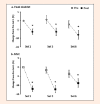Effects of between-set interventions on neuromuscular function during isokinetic maximal concentric contractions of the knee extensors
- PMID: 24149550
- PMCID: PMC3761517
Effects of between-set interventions on neuromuscular function during isokinetic maximal concentric contractions of the knee extensors
Abstract
The presents study investigated the effects of between-set interventions on neuromuscular function of the knee extensors during six sets of 10 isokinetic (120°·s(-1)) maximal concentric contractions separated by three minutes. Twelve healthy men (age: 23.9 ± 2.4 yrs) were tested for four different between-set recovery conditions applied during two minutes: passive recovery, active recovery (cycling), electromyostimulation and stretching, in a randomized, crossover design. Before, during and at the end of the isokinetic session, torque and thigh muscles electromyographic activity were measured during maximal voluntary contractions and electrically-evoked doublets. Activation level was calculated using the twitch interpolation technique. While quadriceps electromyographic activity and activation level were significantly decreased at the end of the isokinetic session (-5.5 ± 14.2 % and -2.7 ± 4.8 %; p < 0.05), significant decreases in maximal voluntary contractions and doublets were observed after the third set (respectively -0.8 ± 12.1% and -5.9 ± 9.9%; p < 0.05). Whatever the recovery modality applied, torque was back to initial values after each recovery period. The present results showed that fatigue appeared progressively during the isokinetic session with peripheral alterations occurring first followed by central ones. Recovery interventions between sets did not modify fatigue time course as compared with passive recovery. It appears that the interval between sets (3 min) was long enough to provide recovery regardless of the interventions. Key pointsAllowing three minutes of recovery between sets of 10 maximal concentric contractions would help the subjects to recover from the peripheral fatigue induced by each set and therefore to start each new set with a high intensity.During this type of session, with three minutes between sets, passive recovery is sufficient; there is no need to apply complicated recovery interventions.
Keywords: Electromyography; electromyostimulation; maximal strength; recovery; stretching.
Figures



Similar articles
-
Comparison of recovery strategies on maximal force-generating capacity and electromyographic activity level of the knee extensor muscles.J Athl Train. 2011 Jul-Aug;46(4):386-94. doi: 10.4085/1062-6050-46.4.386. J Athl Train. 2011. PMID: 21944070 Free PMC article.
-
Neuromuscular fatigue development during maximal concentric and isometric knee extensions.J Appl Physiol (1985). 2006 Mar;100(3):780-5. doi: 10.1152/japplphysiol.00737.2005. Epub 2005 Nov 10. J Appl Physiol (1985). 2006. PMID: 16282433
-
Maximal voluntary eccentric, isometric and concentric torque recovery following a concentric isokinetic exercise.Int J Sports Med. 2003 Jan;24(1):51-6. doi: 10.1055/s-2003-37199. Int J Sports Med. 2003. PMID: 12582952 Clinical Trial.
-
EMG activity and voluntary activation during knee-extensor concentric torque generation.Eur J Appl Physiol. 2002 Apr;86(6):541-7. doi: 10.1007/s00421-002-0579-3. Epub 2002 Mar 7. Eur J Appl Physiol. 2002. PMID: 11944103
-
Central and peripheral fatigue of the knee extensor muscles induced by electromyostimulation.Int J Sports Med. 2005 Dec;26(10):847-53. doi: 10.1055/s-2005-837459. Int J Sports Med. 2005. PMID: 16320169
Cited by
-
Post-Activation Potentiation Increases Recruitment of Fast Twitch Fibers: A Potential Practical Application in Runners.J Hum Kinet. 2018 Dec 31;65:69-78. doi: 10.2478/hukin-2018-0021. eCollection 2018 Dec. J Hum Kinet. 2018. PMID: 30687420 Free PMC article.
-
Effect of Static Stretching on Agonists, Antagonists, and Agonist-Antagonist Combination on Total Training Volume.Int J Exerc Sci. 2023 May 1;16(4):665-675. doi: 10.70252/AKGR8444. eCollection 2023. Int J Exerc Sci. 2023. PMID: 37621382 Free PMC article.
References
-
- Babault N., Desbrosses K., Fabre M.S., Michaut A., Pousson M. (2006) Neuromuscular fatigue development during maximal concentric and isometric knee extensions. Journal of Applied Physiology 100, 780-785 - PubMed
-
- Barnett A. (2006) Using recovery modalities between training sessions in elite athletes. Does it help? Sports Medicine 36, 781-796 - PubMed
-
- Bigland-Ritchie B. (1984) Muscle fatigue of human voluntary and stimulated contractions. Ciba Foundation Symposium 82, 130-156 - PubMed
-
- Bogdanis G.C., Nevill M.E., Lakomy H., Graham C., Louis G. (1996) Effects of active recovery on power output during repeated maximal sprint cycling. European Journal of Applied Physiology 74, 461-469 - PubMed
-
- Gandevia S.C. (2001) Spinal and supraspinal factors in human muscle fatigue. Physiological Reviews8, 1725-1789 - PubMed
LinkOut - more resources
Full Text Sources
